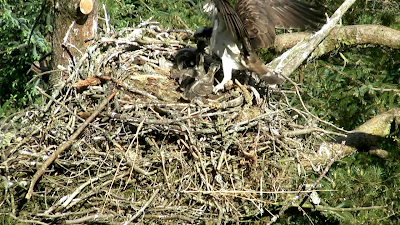 |
| Our hungry chicks jostle for food |
When dad arrives with a big fish, the hungry chicks become very animated and jostle for best position in the nest to be fed.
Mum takes the fish from dad and then in an orderly manner, feeds the chicks with strips of raw fish. She will continue to feed, until all three bellies are full and the chicks begin to shuffle away and lose interest.
 |
| Our new osprey family |
Occasionally, the parents may look skyward with alarm as other birds fly over the nest. Often, this may be harmless passers-by or inquisitive ospreys.
At the young chick stage, this could be a threat if it was a crow or a buzzard but the parents are nearly always nearby.
If one of the adult birds is not actually sitting in the nest with the chicks, then they are usually on a nearby perch and can protect the young when needed to. The chick response when there is any sign of danger is to lie flat in the nest and play dead. The parents give off high pitched alarm calls and this alerts the chicks to be on their guard.
The chicks usually have darker more orange coloured eyes than that of the parents’ bright yellow irises and this begins to change as they develop. Their faces have changed in appearance and they are beginning to look more like little ospreys, with large hook ended strong beaks for tearing fish and the stripe down the crown of the head, as well as the dark eye-stripe. The wings are showing the first signs of feathering breaking out down the shafts of the pin feather, the mid rib tube, which splits to unfold the genuine feather. The soft grey down of their bodies will also become covered over the coming weeks with their first true feathers, which will be brown in colour with a golden edge to each.
Heron
The heron nest on camera remains empty and is a sad reminder of the differences between the species, with ospreys being great parents and protective of their young, whereas, the heron’s lack of good parenting led to the two chicks being left in the nest alone and it was raided by an opportunistic crow. Both chicks have gone and then the crow obviously made a return trip to take the third egg too. Although this is a sad occurrence to us, it is nature in the raw and the hapless heron parents will hopefully have better luck next season. The crow family would have full bellies and this struggle of the survival between species is on a grand scale, biologically, likely to balance out over time. Only if the crow population becomes overly large which can happen, to tip the balance and then conservation action in the form of intervention or population culling could be an option. Mostly nature does a good job of ensuring the survival of the fittest and apart from local fluctuation, populations between predator and prey species tend to reach a balanced proportion.
Blue tit
The blue tit family have grown and are squashed into the cup of the nest. We have counted nine chicks but often when the parent comes in to feed them, only six or seven gaping beaks can be seen as they all struggle in the small space to reach up for feeding time. It will be a matter of maybe a week or so now until they will fledge and leave the snug little nest box.
Swallow
The swallows have made their nest on the edge of the fishery building at Kailzie, and a camera has been put into position to watch them for the season. The swallow is incubating eggs at the moment and all that can be seen is her head and tail poking out of the mud cup nest. As soon as the eggs hatch, the young chicks will line up at the edge of the nest for feeding and we will be treated to superb views of this little family.
No comments:
Post a Comment
Please feel free to leave your comments on the blog. We've got a few house rules:
1. We (Forestry Commission Scotland) will review all comments and reserve the right to not publish them at our discretion.
2. There will be a time delay between submission and posting. Comments posted on a Saturday or Sunday won't be moderated until the following Monday.
3. Please make comments appropriate and relevant.
4. If you've a comment or question about Tweed Valley Ospreys , you can e-mail tweedvalleyospreys@gmail.com as we might not be able to respond here.
5. We won't publish comments that are abusive, indecent, unlawful or defamatory; published comments may be removed at any time; and individuals are personally liable for the comments they submit.
Thanks!